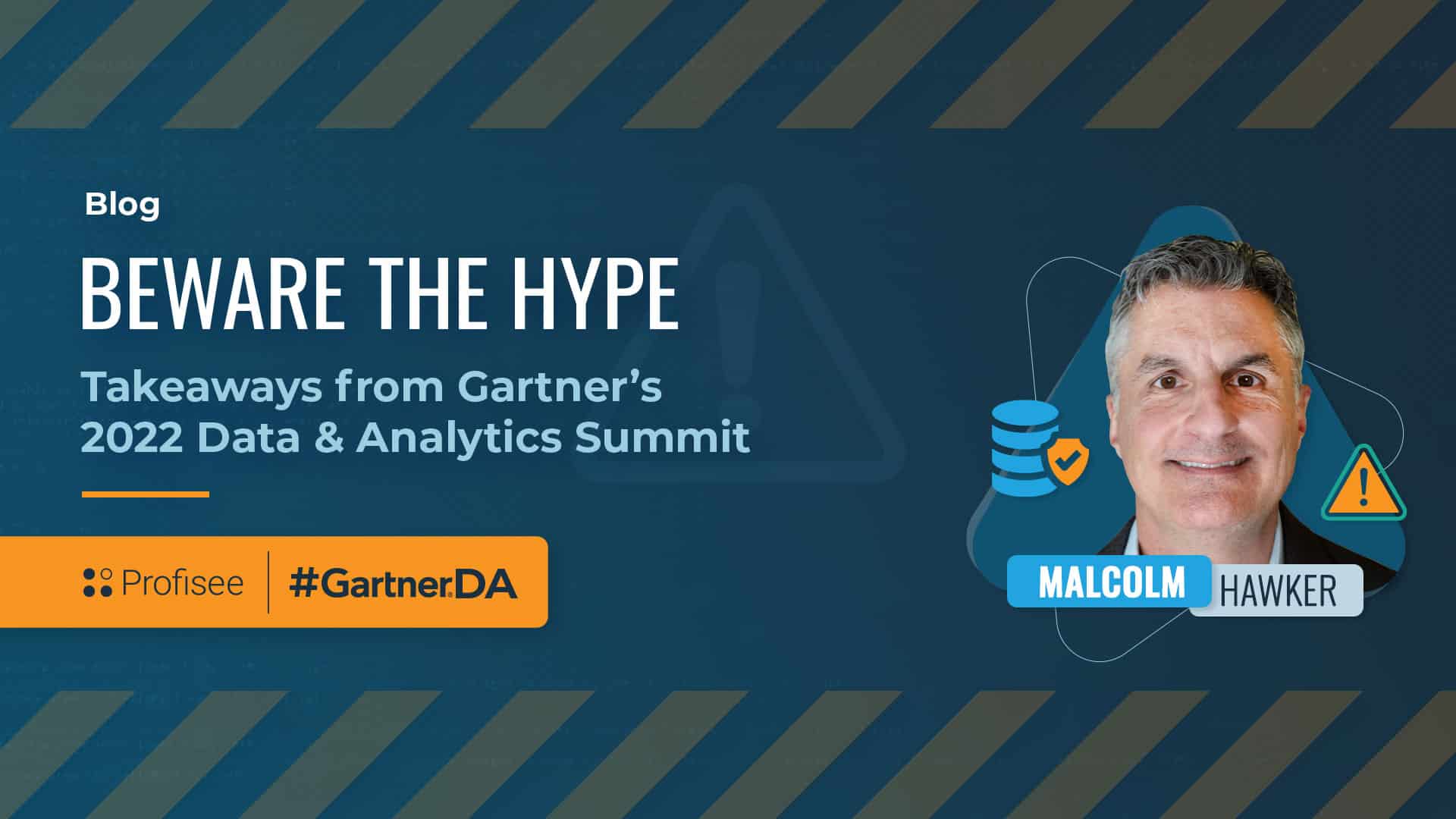It was an action-packed three days in Orlando, Florida, at the recent 2022 Gartner Data and Analytics Summit, where I joined over 5,500 of my fellow data leaders and practitioners after what seemed like an eternity since the last summit in March of 2019. It was great to be back around some familiar faces and my old Gartner analyst peers, and I left the event incredibly optimistic about the state of our industry.
As you should expect at these events, there was a broad mix of coverage on trends and topics, all of which have significantly different timelines for mass adoption — not unlike the often-quoted Gartner hype cycle itself. Speaking from years of experience, it’s easy to get caught up in all the hype of some trends at these events — especially since all the vendors are working hard to amplify the hype and generate excitement for their products.
After attending the event, it would be natural for a data and analytics leader to think they were 10 years behind on just about every new development in the field — when in reality there are probably only three ways of looking at any of the major topics discussed in Orlando:
- A topic may be interesting, but not yet ready for primetime,
- It may be fully in its prime and worth any CDO’s consideration
- Or it’s something you absolutely already need a plan for.
It’s through these three lenses that I look at the more compelling evolutions in our space.
Interesting, But Not (Yet) Ready for Prime Time
1. Data Fabric
I made a point to attend most sessions on the data fabric, and I was comforted to hear Mark Beyer clearly articulate that we are easily over 5 years away from any sort of mass adoption here.
Mark highlighted that the data fabric has jumped from 3% to 6% market adoption (if you can actually name the 4-5 companies who implemented a true fabric in the last year, you get a prize). But given the hype from both Gartner and several vendors at the event, one could naturally assume that nearly everyone has a data fabric these days. This is not true, and even with Mark acknowledging the low adoption, I still believe Gartner is well ahead of its skis on the data fabric.
One interesting side note: After attending this Gartner event, one could also wonder if the data mesh even exists. It does, but Gartner seems to be pretending it doesn’t.
2. Fully Autonomous (or Ethical) Anything
Yes, we should expect that robots, algorithms, smart devices and other forms of artificially intelligent technology will significantly help automate how we manage and analyze our data someday in the future.
However, when you peel the onion here on most of these data and analytics technologies right now, you’ll see there is a very basic level of automation on some rote processes with added doses of augmentation that still require human engagement. This is especially the case for any process that requires rules/policies to be defined or managed by humans (see below). Beware of any vendor trying to sell you a solution that relies on anything (including AI/ML) that you can’t explain, or defend, to your stakeholders.
3. Fully Adaptive Anything, Especially Data Governance
I truly look forward to the day when CDOs can claim victory over data governance, but we remain a long way from the finish line. The sad truth — by Gartner’s own data — is that the level of data governance maturity at most organizations remains extremely low.*
This means having ‘adaptive’ data and analytics systems that are contextually use-case, user, or application-driven is a *massive* stretch for most organizations. To be ‘adaptive’ requires an exponential increase in the number of if-then scenarios that need to be modeled, managed and — more importantly — defined by a governance program.
Companies wrestle with having just a single scenario well governed for a given user interaction with data — let alone thousands and thousands.
Prime Time – Ignore at Your Peril
1. Master Data Management, Data Quality and Data Integration
A digital future built on a foundation of bad data is a recipe for disaster. Given the attendance at some of the ‘data management fundamentals’ presentations (including a master data management session hosted by yours truly), it’s clear that companies are finally, and rightfully, recognizing this.
I would urge Gartner to take a hard look at its coverage in these critical areas. Just because something is moving to the plateau of productivity doesn’t mean it’s not worthy of significant analyst investment.
2. Data management in the cloud, cloud management and cloud optimization
Cloud migrations are table stakes. The question is now more about cloud optimization and management, where companies increasingly have multiple clouds, multiple vendors, and multiple operational paradigms that can create a massive headache for even the most seasoned I&O expert.
Data sharing, shared access management, and other tools to optimize/virtualize the management of data across clouds are a must-have. Mega-vendors have an advantage here, but fears of lock-in are well-founded.
3. Data cataloging, profiling and metadata management
If you think the data fabric — or any level of automation/augmentation on data management — is a real thing, then you need to get your hands around your metadata. Quickly.
The models and algorithms needed to automate, augment or adapt your data and/or data management processes will ALL be built on metadata — and it all starts with a data catalog.
You Should Have Already Had a Plan for This
1. Innovation and Agile applied to Data Management — ‘Good Enough is Good Enough’
The summit keynote address was well-delivered by Gareth Herschel and Debra Logan, but I found the core messages to be a bit dated.
I’m paraphrasing here, but one of the key messages I heard in the keynote was that D&A leaders need to be more Agile (notice the capital ‘A’) and take more of an ‘MVP’ type approach across data management and decision-making. This is most certainly not new — although it was refreshing to hear Gartner admit that being pragmatic is often more valuable than just blindly following best practices, which are often more academic than practical.
2. Data as a Product
As a former Chief Product Officer, I find this ‘trend’ both invigorating and highly frustrating. The idea that data and analytics leaders should just now be focusing on data as a product is completely misguided — I would argue things should have always been this way.
Had this always been the case, perhaps we would have a better handle on things like building roadmaps, understanding how people use our data, prioritization and ROI models. In other words, industry pundits like me have been saying to treat data like a product for a long time — we just haven’t been using those exact words. Will using these words help move the needle on having data and analytics leaders be more customer and outcome-driven? I sure hope so.
3. Data Strategy
The data strategy sessions by Mike Rollings and Frank Buytendijkv were well attended, where a big focus was the Gartner Data and Analytics Strategy and Operating Model (DASOM). This is a useful model, although I would argue the core message of the model is not fundamentally different from any of the strategy models that have been for the last 10+ years.
Given the task of defining a data strategy is one of the three top deliverables of a CDO (and given the growth of the CDO roles), hopefully in the extremely near future companies will finally reach a point where creating a data strategy is not considered novel.
4. Data Literacy (AKA User Training), Change Management and other Go-to-Market ‘Stuff’
I posit that if companies were truly treating data as a product, then a core deliverable of the data product manager would be a go-to-market (GTM) plan, which includes all aspects of user training required to have customers be sufficiently ‘literate’ with the data.
The GTM plan would also include all aspects related to change management — be those changes internal (like a QA process, code management or internal documentation) or external (like what is required for users to get value from the change, including updated governance policies).
I hope that in another 2-3 years we stop talking about data literacy, and instead just focus on making sure our products can be used in a value-generating way. Have you ever heard a product manager talk about Product Literacy? No, you haven’t, and that’s exactly my point.
5. Sufficiently Skilled Resources
Again, this is not a new message. We’ve been talking about a dearth of skilled resources in the D&A space for a long, long time. It’s what leads some of us to flirt with offshoring, nearshoring and everything in between.
Some technical advancements (like AI and Graph) are driving new resource requirements here (not to mention new labels on old roles that haven’t meaningfully changed much), but if you’re a D&A leader without a solid foundation for recruitment, compensation, staffing and employee development, your job just got much, much harder.
(Bonus) Noticeably Absent from Significant Coverage at The Summit
1. ESG (Environmental, Social, Governance)
Pre-pandemic, I would have fully expected environmental, social and governance (ESG) issues to be a top trend in the Data and Analytics world. However, in a post-pandemic world of supply chain shocks, energy shortages and economic chaos, it appears ESG is taking a back seat to other business priorities.
It remains to be seen if this will remain the case, or if ESG will again assert itself back into corporate boardrooms and Gartner summit agendas.
2. Blockchain, DAOs and Crypto
If you ask me, Gartner’s lack of coverage here is an enormous miss. I would argue that blockchain, particularly distributed ledger technology, has a far greater chance of being mass adopted in the next 7 years than the data fabric.
Yet, for some reason, the Gartner data and analytics community is completely ignoring one of the biggest trends in technology today. Why?
Again, it was incredible seeing many of my former colleagues and connecting with thought leaders and practitioners across the data management space. I was especially thrilled to share the stage with Patrick Terry, CDO of BOK Financial, and discuss ‘The Twin Superpowers of the CDO and MDM.”
It’s important we celebrate our successes and highlight data leaders who are delivering value to their organizations, so I am thankful Gartner provided us a venue for that.
I hope to see many of you at next year’s summit — but be sure to beware the hype, focus on what matters to your business and don’t get discouraged if you’re not already adhering to some ‘best practice.’ The value of data management is gleaned in the trenches, and it’s my mission to share the insights of battle-tested approaches to becoming more data-driven.
Follow me on LinkedIn at the link below and be sure to listen to my conversations with CDOs on the CDO Matters podcast.
[i] In June of 2020 Gartner published “The State of Data Governance is Worse Than You Think”. In this document, Gartner noted that only 13% of companies have data governance KPI’s that are being measured.
Malcolm Hawker
Head of Data Strategy @ Profisee

Malcolm Hawker
Malcolm Hawker is a former Gartner analyst and the Chief Data Officer at Profisee. Follow him on LinkedIn.













